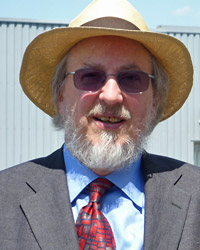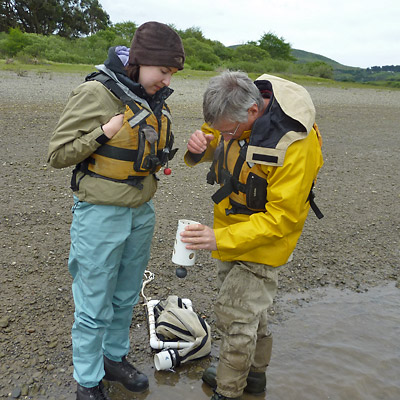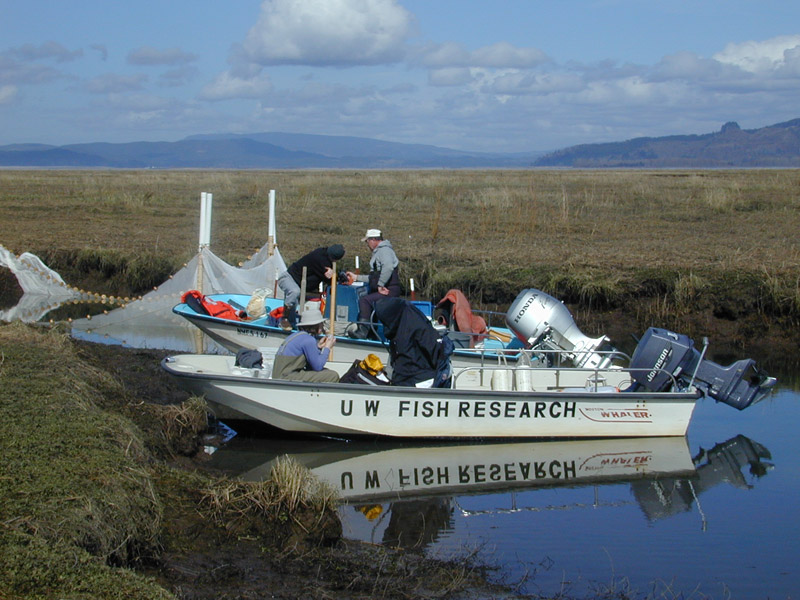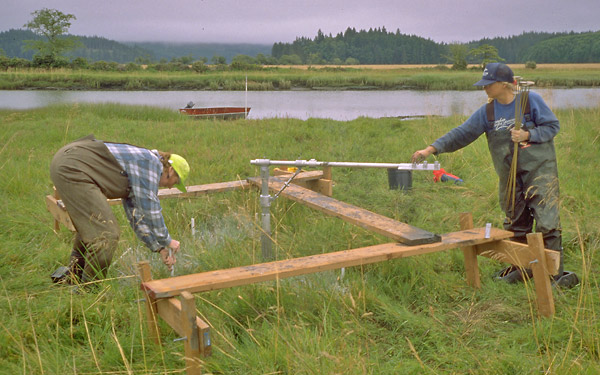Spring-Summer
2013
Faculty Feature:
Charles "Si" Simenstad and the Wetland Ecosystem Team

Charles “Si” Simenstad (photo courtesy of G. Fontenelle).
Charles “Si” Simenstad has been with SAFS for nearly five decades. Originally from Sunnyside, Washington, he enrolled in the then UW Fisheries program in the mid-1960s, earning both his BS (1969) and MS (1971); after graduation, he remained in UW Fisheries, working as a fisheries biologist until he was appointed research professor in 2001.
Most of his research at SAFS has involved working on temperate estuarine and nearshore coastal ecosystems. When he was an undergraduate, he joined Professor Ernie Salo’s team, which was conducting a study on juvenile and adult salmon passage through Elliott Bay and the Duwamish River estuary. He noted, “This was back when the Duwamish was much more degraded than it is now, and I think a lot of my professional compass toward reversing environmental degradation came from that project and Ernie’s philosophy.”
By the mid-1980s, Si was working with several Fisheries Research Institute (FRI) faculty on research ranging from nearshore community structure and food webs in the Aleutian Islands to nearshore fish and food webs of northern Puget Sound and the Strait of Juan de Fuca.
At this same time, he was collaborating with staff biologist Ron Thom on estuarine wetlands. They were particularly interested in assessing wetland mitigation, which led them to study one of the first estuarine wetland restoration sites in Puget Sound—the Gog-Le-Hi-Te wetland in the Puyallup River estuary. Si observed, “Our association, and the emergence of a cohesive team of graduate students and staff, prompted Ron and me to form the Wetland Ecosystem Team (WET).”
MD:What is WET all about?
Si:While WET researchers originally focused on applied research on estuarine wetland ecosystems in Puget Sound, we now study everything from the fine-scale attributes of fish habitat—for example, juvenile salmon foraging in emergent tidal marshes—to basic research into ecosystem processes at landscape scales—such as understanding how estuarine water circulation affects food webs.
The WET team works in estuarine and coastal areas, including the San Francisco Bay–San Joaquin/Sacramento Delta, coastal Oregon and the Columbia River estuary, the Puget Sound/Salish Sea, and Alaska. Staff member Jeff Cordell (MS 1986) has gone as far as Tahiti to explore invasive zooplankton around coral reefs!

WET research scientist Jeff Cordell and graduate student Erin Seghesio (MS 2011 SAFS) collecting invertebrates in the Russian River estuary , California (photo courtesy of C. Simenstad). Click photo to view larger image.
MD: How do you decide which projects to pursue?
Si:Projects should provide full support for a SAFS or other UW graduate student. They should focus on estuarine and coastal ecosystems, of course, and even very specific applied questions should still support basic science. Because of our special expertise in high-resolution taxonomy of estuarine/coastal marine wetland invertebrates, we also assist resource agencies and other collaborators.
MD: There is a more personal evolution in this story, too. What was that?
Si:In 2001, I moved from a research staff position to become research faculty. This allowed me to increase WET’s role in graduate student guidance. This was one of the more fortunate transitions in my career, and likely would not have happened without help from Bud Burgner, school directors Marsha Landolt and Dave Armstrong, and then-College of Ocean and Fishery Sciences Dean, Arthur Nowell.
MD: How is the “Team” in “Wetland Ecosystem Team” manifested?
Si:I emphasize to prospective graduate students that everyone is expected to contribute, be it mentoring new students or Capstone undergraduates, assisting in field studies for each other’s projects, or providing statistical, analytical or taxonomic expertise.
There’s also something to be said for having a spectrum of ages, expertise, and backgrounds in the foundation of the lab, which provides a scientific and institutional memory that the students can always draw on - for example, Jeff and I have worked together for 35 years!.
MD: What are some highlights of the WET program?
Si: That’s easy: Some 35 WET graduate students have gone on to make substantive contributions to science, resource management, and society overall.
Every student and staff member contributes substantively to WET and our science, regardless of their career path. And, largely, they do this by building on each other’s history to progressively advance our understanding about coastal ecosystem organization and function, from the species to the landscape scale.
I am most gratified by students and staff who have carried forward the lessons we have tried to instill in WET about the importance of incorporating rigorous science in resource management issues, formulating testable hypotheses and questions into sampling designs and experiments, determining what resources like salmon require from a landscape mosaic of ecosystems, understanding what promotes sustainable restoration, and knowing when it is their ultimate responsibility to “represent the fish.”
I think that Jeff, Jason Toft (staff; MS 2000) and I have always been in our true “WETspace” with a student or staff member pulling a beach seine or sucking up fish prey along a beach, marsh, or eelgrass meadow. But then there was the large-scale research on ecosystem dynamics in which we have led interdisciplinary, multi-institutional teams. To truly understand ecosystems at the landscape scale, you need the best interdisciplinary team you can get, and WET students and staff have always been totally invested in this intensely interactive research and, perhaps most important, they have been and continue to be fun and inspiring to work with.
MD: During the last 30 years, how have our nearshore environments changed and what role has WET had in this change?
Si: WET has existed in an era of phenomenal change in estuaries worldwide, particularly in the Pacific region of North America. And in some cases we have even turned the corner toward ecosystem rehabilitation, if not actual restoration.
Although it’s telling of how long I’ve been wandering these waters, I will relate the history of change in the Duwamish River estuary from a personal perspective.
My grandfather settled in Seattle in the late 1800s and my father grew up on 13th Avenue in north Capitol Hill. I grew up listening to stories translated through the eyes of a kid and young man prowling, fishing, and sailing the waters of Lake Washington, Elliott Bay, the Duwamish River estuary, and Puget Sound. This is before the Lake Washington Ship Canal was completed, and stormwater and sewage ran down the north drainages of Capitol Hill to accumulate in Portage Bay!
My father described the Duwamish River from memories of it both roiling with 30-pound (or larger) Chinook and possessing all the worst facets of the progressive, industrial development that gobbled up 98% of the estuary’s historic wetlands and sullied the air and water far beyond anything seen today.
Jump one generation and half a century: I had just finished my sophomore year at the School of Fisheries and worked as a “junior-junior” fisheries biologist, sampling juvenile and adult salmon on the Duwamish River estuary. I remember tow-netting for juvenile salmon as we passed under pipes spewing blood and offal out of the slaughterhouses, and acrid, smoking metallic liquids out of the foundries. In the summer, adult Chinook and chum salmon queuing up at the mouth of the waterway often had to wait days to weeks for a bit of precipitation to disrupt the “plug” of low dissolved oxygen that blocked their path.
Witness the Duwamish today: We have extensively rehabilitated estuarine wetlands, enhanced the migratory and foraging habitat of out-migrating salmon, and improved water and air quality and a societal sense of the estuary as becoming a place that can actually be lived in and enjoyed. The legacy of long-lived contaminants does persist in the estuary’s sediments, but at least we know of the scope of that pollution and the need to purge its impact.
MD: WET puts a lot of effort into communicating about its work. Who are your audiences?
Si: Given our very applied ecology emphasis, we’ve always worked closely with resource management agencies to communicate our research results so they can roll the best, most current science into policy and regulation.
We are also at the “frontline” of public exposure to applied science, especially our urban shoreline ecology studies. For example, there are the Olympic Sculpture Park and Seattle Seawall projects that Jeff and Jason Toft are conducting. There is nothing like pulling a beach seine up onto the downtown Seattle–Elliott Bay shoreline to initiate interaction with a crowd of school children, morning joggers, and other intrigued, inquisitive, and enthusiastic observers!
MD: What do you see in WET’s future?
Si: The need to educate and produce young scientists to deal with the emerging challenges of applied estuarine/coastal science issues is ever more important throughout the Pacific Northwest and perhaps the USA overall.
Although SAFS has many competing priorities and limited resources, I have to hope that the School will continue to consider estuarine and nearshore ecology a priority—especially replacing expertise of departing or departed faculty.

Small boat operations of the collaborative NOAA-NWFSC and SAFS-WET team studying the ecology of juvenile Chinook salmon in emergent marsh tidal channels of the lower Columbia River estuary (photo by C. Simenstad). Click photo to view larger image.

Indicative of the WET penchant to conduct multi-institutional, interdisciplinary wetland research, Dr. Denise Reed and Ms. Wendy Morrison from the University of New Orleans assist WET in measuring sediment accretion in an estuarine coastal marsh (photo by C. Simenstad). Click photo to view larger image.
